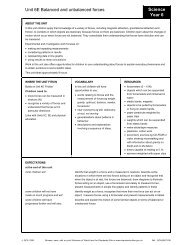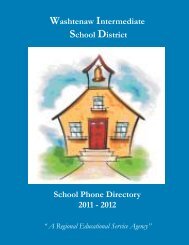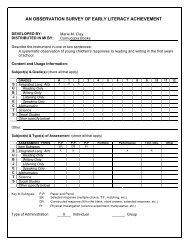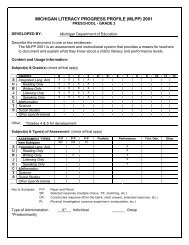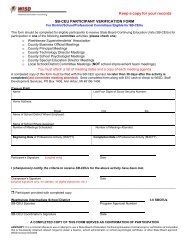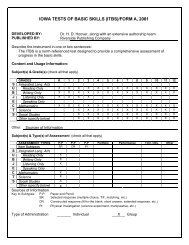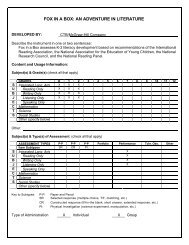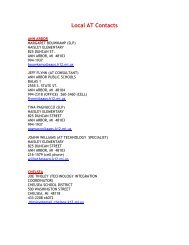Parent Advisory Committee - Washtenaw Intermediate School District
Parent Advisory Committee - Washtenaw Intermediate School District
Parent Advisory Committee - Washtenaw Intermediate School District
You also want an ePaper? Increase the reach of your titles
YUMPU automatically turns print PDFs into web optimized ePapers that Google loves.
SPECIAL CIRCUMSTANCESRe-evaluationsEvery student eligible for special education services qualifies to receive a comprehensive re-evaluation at least everythree years. Rather than simply having the three-year re-evaluation address eligibility, this allows the IEPT (You arean essential member of this team) to decide what data/tests are needed to organize a comprehensive review of eachstudent’s progress and needs for special education services. A discussion of assessment options for a student’s reevaluationshould occur before the three-year re-evaluation is due.Developing Visions and GoalsPlanning systems can and should be used for students of any age. Some systems are more suited to planning forschool, while others involve many or all aspects of a student’s life. Some planning systems are Circle of Friends,COACH (Choosing Options and Accommodations for Children), Curriculum Matrix, MAPS (Making Action Plans), PATH(Planning Alternative Tomorrows with Hope), and Person Centered Plan (PCP). Facilitators and assistance in utilizingthese methods can be found at organizations such as WISD, ACA (Association for Community Advocacy), AutismSociety of Michigan (ASM), CMH (Community Mental Health), and/or the Arc of Michigan.TransitionsTransitions of varying degrees will occur often during a student’s time in school. There are transitions from anIndividualized Family Service Program (IFSP), when a child reaches age three, to an Individualized EducationalProgram (IEP) when a student enters a preschool or school program. There are transitions from grade to grade, frombuilding to building, and from level to level. At any time of transition, it is helpful for the student and his/her family toprepare by talking with and meeting new staff, exploring the facility, looking at transportation and any other newexperiences, which the student may encounter. For instance, if lockers are new to the student, try one out todetermine if a key lock is needed instead of a combination. Consider having the next IEPT meeting at the new school.Invite the staff from both grades and/or schools. Arrange for your student to experience a day at the school befores/he actually attends. Go to the new school often so your student is familiar with the facility. Preparation will meanthat, when the transition occurs, it does not seem like such a big change.Student’s Post-Secondary GoalsIt is important that the IEP be driven by the student’s relevant preferences and goals for his/her post-secondaryschool activities. If the student did not attend and participate in the IEP team meeting, it is required to at leastindicate the steps taken to ensure that the student’s preferences were considered. The following questions are astarting point for a discussion with the student about future dream and goals:1. As an adult, where do you want to live?2. As an adult, what kind of work do you want to do?3. As an adult, what hobbies and activities do you want to have?4. After high school, what additional education and training do you want?Transition planning to adult lifeTransition (as defined by the IEP) refers to a coordinated set of activities designed to help a student with a disabilityprepare for adult roles and responsibilities. IDEIA 2004 requires that transition planning begin at age 16. This is whenthe IEP Team must address a student’s pre-vocational/vocational needs. For students aged 16 or older, the IEPTmust consider the need for transition services and this is documented on the transition page of the IEP. This mustinclude a statement of transition service needs of the student, which focuses on the student’s course of study (such asparticipation in advanced placement courses or a vocational program). The IEP may determine what instruction andeducational experiences will assist the student to prepare for transition from secondary education to post-secondarylife. At age 16 (or younger if appropriate), referral(s) should be made for needed transition services, such as MichiganDepartment of Career Development/Rehabilitation Services. The local educational agency must invite the student anda representative of any agency that is likely to be responsible for providing or paying for transition services. If an14





